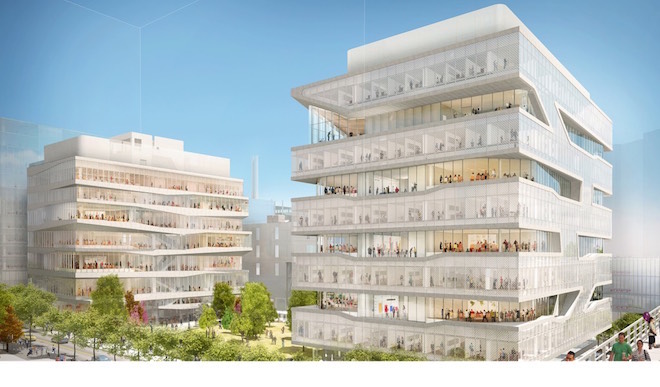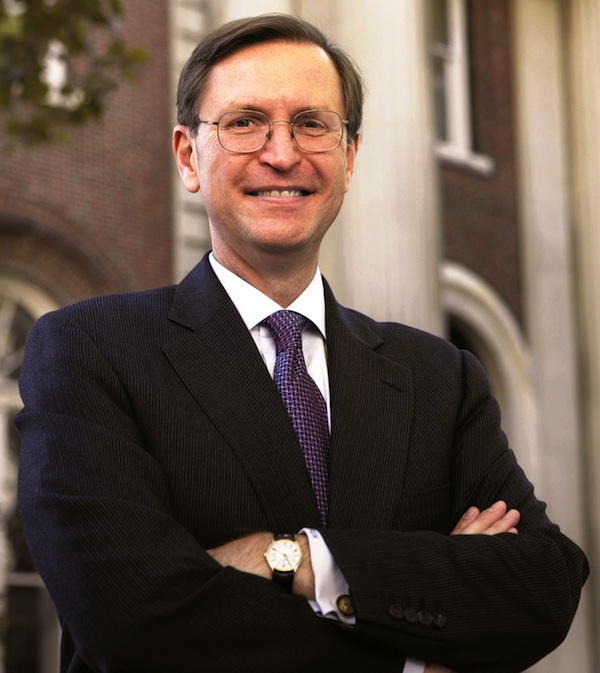
An easy satirical target for Columbia Business School students who put together the annual Follies Show has long been the school’s antiquated building. This spring, MBA jokesters again poked fun at the building’s crowded library and congested deli, noting that there was “nowhere to seat us, recruiters can’t meet us.” And in a video sendup of the MBA rankings game, one MBA student gleefully noted: “Now we’re getting a new building. We’re getting it done. We said 2016, but it’ll be in ’31.”
Not quite, but what a long strange trip it’s been. After all, the new home for CBS won’t open for classes until early 2022, nearly five years from now and more than 15 years since school administrators began to discuss the opportunity to relocate to what would become the university’s Manhattanville campus. Northwestern University’s Kellogg School of Management, which opened its new home in March, was able to get its new complex up in less than seven years.
But things are much more complicated, expensive and time-consuming in New York, especially when it comes to a huge plot of land in a city where every inch of real estate is precious and competitive. Earlier this month, Dean Glenn Hubbard successfully completed a $500 million capital campaign that will cover the total cost of the two new buildings. That is twice as much as Kellogg spent on a complex that is only slightly smaller at 415,000 square feet. Columbia’s new home will more than double the size of the existing facility. The business school’s primary home, Uris Hall, is so cramped for space that CBS is now housed in two on-campus buildings with some support staff working out of a pair of off-campus facilities.
‘WE ARE SERIOUSLY SPACE CONSTRAINED IN OUR OLD ENVIRONMENT’

Dean Hubbard completed a $500 million capital campaign for the new complex this month
Since the decision was made to replace Uris Hall, several peer schools have gone from start to finish on new modern facilities, including Stanford University’s Graduate School of Business, Yale University’s School of Management, and Kellogg. Many believe that the rectangular concrete block that is home to CBS is the least desirable and most cramped facility at any leading business school.
“We are seriously space constrained in our old environment,” says Janet Horan, vice dean of administration and chief operating officer. Indeed, when class lets out, the hallways are as crowded with students as the underground subway tunnels at 42nd St. There’s limited space for team meetings, conferences, small group seminars and co-curricular clubs and organizations, and there are few flexible classrooms.
Columbia Business School’s new home will dramatically change all that. The complex will span approximately 492,000 square feet across two buildings situated between a 40,000-square-foot open area to be known as The Square. The two buildings will be named for the project’s largest donors, Ronald Perelman, chairman and CEO of MacAndrews & Forbes Holdings, and Henry Kravis, co-founder and co-CEO of the leveraged buyout firm Kohlberg Kravis Roberts & Co. Kravis gave a landmark gift of $125 million, while Perelman ponied up $100 million for the complex.
LONG DELAY PARTLY DUE TO RELOCATION TO THE NEW MANHATTANVILLE CAMPUS
Why the long delay? The move to a new university campus is clearly one factor. The university is redevelopoing a onetime industrial area largely populated by warehouses, parking lots and garages. The space required a major rezoning plan, which won approval from the City Council in 2007, for academic and residential mixed use. It includes more than 17 acres of property on the blocks from West 125th Street to 133rd Street between Broadway and 12th Avenue, as well as several properties on the east side of Broadway, from 131st to 134th Street.
“We were not really a part of the negotiations with the city,” says Horan. “The university worked with the city to get approval for the whole campus. We started ten years ago, probably even a little longer than that in working with the university on a new campus and where the business school would fit into that.”
“The best project always takes the greatest amount of time,” says Christopher Cashman, a spokesperson for Columbia Business School. “We have our eyes set on 2021. The biggest challenge is also the biggest advantage. There are already some other habitants so we will join a virbrant community. On one hand, it is a challenge because the university planned this expansive space. We are fortunate to be on there but we are just one part of it. On the other hand, the fact we are the next academic building to go up and will be joining a vibrant community is a plus.”
The Long & Winding Road Toward A New Business School At Columbia
| Date | Development |
|---|---|
| 2003 | President Bollinger announces the intention to build a campus in the old Manhattanville manufacturing zone of West Harlem |
| 2006 | Manhattanville Campus slated to include a site for a single business school building |
| 2007 | Columbia University begins the Uniform Land Use Review Procedure in June and finishes in December |
| 2008 | General Manhattanville Project Plan adopted and affirmed. Business School now slated for two buildings. Capital campaign launched and architect search begins |
| 2011 | Architects Diller Scofidio + Renfro in collaboration with FXFowle are selected to design the business school’s two new buildings |
| 2014 | Design phase for underground facilities approved |
| 2015 | Construction phase for facilities approved |
| November,2016 | Excavation began |
| May, 2017 | Completion of $500 million capital campaign for business school complex |
| December, 2021 | Expected completion of new b-school buildings |
| January, 2022 | Classes begin in new business school complex |









